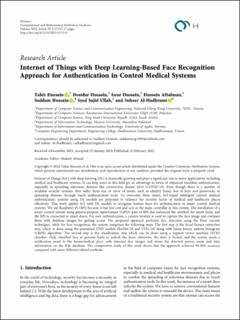Internet of Things with Deep Learning-Based Face Recognition Approach for Authentication in Control Medical Systems
Hussain, Tahir; Hussain, Dostdar; Hussain, Israr; Alsalman, Hussain; Hussain, Saddam; Sajid Ullah, Syed; Al-Hadhrami, Suheer
Peer reviewed, Journal article
Published version
Permanent lenke
https://hdl.handle.net/11250/3007186Utgivelsesdato
2022Metadata
Vis full innførselOriginalversjon
Hussain, T., Hussain, D., Hussain, I., AlSalman, H., Hussain, S., Ullah, S.S. & Al-Hadhrami, S. (2022). Internet of Things with Deep Learning-Based Face Recognition Approach for Authentication in Control Medical Systems. Computational and Mathematical Methods in Medicine, vol. 2022, 17. https://doi.org/10.1155/2022/5137513Sammendrag
Internet of Things (IoT) with deep learning (DL) is drastically growing and plays a significant role in many applications, including medical and healthcare systems. It can help users in this field get an advantage in terms of enhanced touchless authentication, especially in spreading infectious diseases like coronavirus disease 2019 (COVID-19). Even though there is a number of available security systems, they suffer from one or more of issues, such as identity fraud, loss of keys and passwords, or spreading diseases through touch authentication tools. To overcome these issues, IoT-based intelligent control medical authentication systems using DL models are proposed to enhance the security factor of medical and healthcare places effectively. This work applies IoT with DL models to recognize human faces for authentication in smart control medical systems. We use Raspberry Pi (RPi) because it has low cost and acts as the main controller in this system. The installation of a smart control system using general-purpose input/output (GPIO) pins of RPi also enhanced the antitheft for smart locks, and the RPi is connected to smart doors. For user authentication, a camera module is used to capture the face image and compare them with database images for getting access. The proposed approach performs face detection using the Haar cascade techniques, while for face recognition, the system comprises the following steps. The first step is the facial feature extraction step, which is done using the pretrained CNN models (ResNet-50 and VGG-16) along with linear binary pattern histogram (LBPH) algorithm. The second step is the classification step which can be done using a support vector machine (SVM) classifier. Only classified face as genuine leads to unlock the door; otherwise, the door is locked, and the system sends a notification email to the home/medical place with detected face images and stores the detected person name and time information on the SQL database. The comparative study of this work shows that the approach achieved 99.56% accuracy compared with some different related methods.
Utgiver
Hindawi LimitedTidsskrift
Computational & Mathematical Methods in MedicineOpphavsrett
© 2022 The Author(s)Beslektede innførsler
Viser innførsler beslektet ved tittel, forfatter og emneord.
-
Evaluation of Deep Learning and Conventional Approaches for Image Recaptured Detection in Multimedia Forensics
Hussain, Israr; Hussain, Dostdar; Kohli, Rashi; Ismail, Muhammad; Hussain, Saddam; Sajid Ullah, Syed; Alroobaea, Roobaea; Ali, Wajid; Umar, Fazlullah (Peer reviewed; Journal article, 2022)Image recaptured from a high-resolution LED screen or a good quality printer is difficult to distinguish from its original counterpart. The forensic community paid less attention to this type of forgery than to other image ... -
Face Mask Detection Using Deep Convolutional Neural Network and MobileNetV2-Based Transfer Learning
Hussain, Dostdar; Ismail, Muhammad; Hussain, Israr; Alroobaea, Roobaea; Hussain, Saddam; Sajid Ullah, Syed (Peer reviewed; Journal article, 2022) -
Efficient and Secure Key Management and Authentication Scheme for WBSNs Using CP-ABE and Consortium Blockchain
Iqbal, Jawaid; Bibi, Hajira; Amin, Noor Ul; Alsalman, Hussain; Sajid Ullah, Syed; Hussain, Saddam; Al-Aidroos, Naziha (Peer reviewed; Journal article, 2022)

